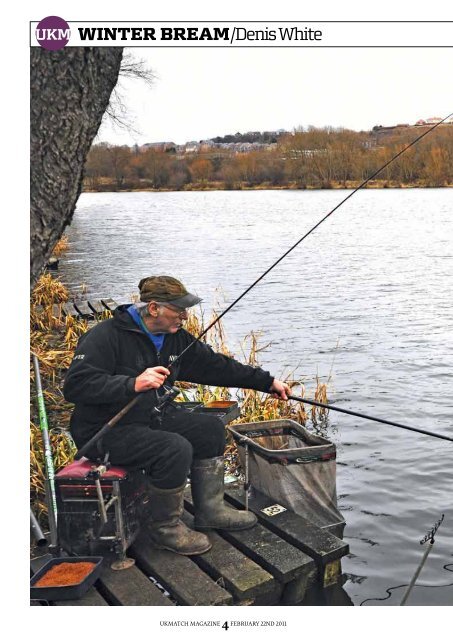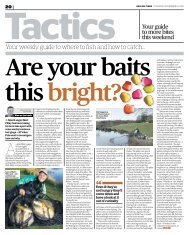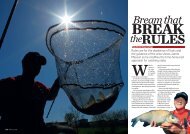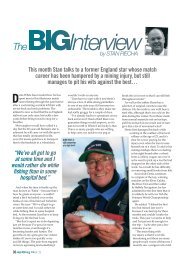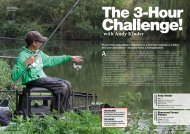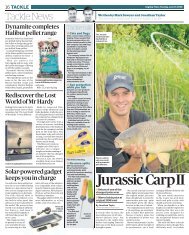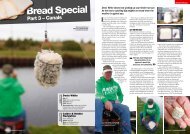4 UKMATCH dennis.indd - Maver Match
4 UKMATCH dennis.indd - Maver Match
4 UKMATCH dennis.indd - Maver Match
Create successful ePaper yourself
Turn your PDF publications into a flip-book with our unique Google optimized e-Paper software.
UKM winter bream/Denis White<br />
<strong>UKMATCH</strong> MAGAZINE 4<br />
February 22nd 2011<br />
4 <strong>UKMATCH</strong> <strong>dennis</strong>.<strong>indd</strong> 4 14/2/11 07:38:04
THE<br />
BEST OF<br />
BRITISH<br />
Never miss<br />
another bite!<br />
Banish those frustrating knocks and taps with a<br />
feeder rig that is so simple to fish, you’ll wonder<br />
why you never thought of it before. Barnsley legend<br />
Denis White is your guide to a whole new way of<br />
winter feederfishing for skimmers<br />
ANGLER FACTFILE<br />
Name: Denis White<br />
Age: 65<br />
Lives: Barnsley<br />
Occupation: Retired miner<br />
Sponsor: <strong>Maver</strong><br />
Denis<br />
White<br />
Barnsley<br />
match legend<br />
‘<br />
Ay Up Fatha!’ came<br />
the welcome on the<br />
other end of the<br />
phone, spoken in<br />
the deepest,<br />
broadest Barnsley accent possible.<br />
The tone belonged to probably one<br />
of the South Yorkshire town’s<br />
most famous angling sons, a man<br />
who has represented his country<br />
on dozens of occasions and was a<br />
founder member of the mighty<br />
Barnsley Blacks – Denis White.<br />
Now of pensionable age, former<br />
miner Denis is still going strong in<br />
matchfishing circles, winning big<br />
matches on river, canal and lake<br />
while finding time to sit on the<br />
Barnsley DAA committee and<br />
throw his heart and soul into<br />
coaching the area’s up and coming<br />
young talent – a full life at a time<br />
when most would be taking it easy.<br />
That’s not for Denis, or ‘Fatha’<br />
as he’s known around the country.<br />
The man lives and breathes<br />
fishing, recently representing the<br />
England Veterans team at their<br />
World Champs. Surrounded by<br />
famous fisheries such as<br />
Worsbrough Reservoir, the<br />
Rivers Don and Trent and the<br />
big shipping canals, he’s had a<br />
matchfishing apprenticeship<br />
second to none.<br />
Fishing with likes of Scotthorne,<br />
Pickering and Clegg domestically<br />
and Ashurst and Nudd at<br />
international level, Denis has a<br />
wealth of knowledge on all manner<br />
of fisheries but if you ask him his<br />
favourite sort of fishing, he’ll<br />
always give you one reply – bream.<br />
“When I’m deaf, blind, senile,<br />
unable to walk or talk and<br />
incontinent, then I might consider<br />
fishing commercials but until<br />
then, not a chance,” Denis joked.<br />
“There’s so much good natural<br />
venue fishing around here that I<br />
can’t understand why people want<br />
to fish the same lake every week<br />
knowing what they’ll catch and the<br />
methods they’ll catch them on.”<br />
For that reason UK<strong>Match</strong> asked<br />
the old-stager to catch some of his<br />
beloved bream. The Ouse was<br />
talked about but with winter rains<br />
ruining that possibility, Denis<br />
suggested a Barnsley lake just a<br />
stone’s throw from the house he<br />
was born in, one he’d fished since a<br />
kid and one full of skimmers.<br />
<strong>UKMATCH</strong> MAGAZINE 5<br />
FEBRUARY 22ND 2011<br />
4 <strong>UKMATCH</strong> <strong>dennis</strong>.<strong>indd</strong> 5 14/2/11 07:38:46
UKM WINTER BREAM/Denis White<br />
He’d promised to fish a feeder<br />
rig with a difference – deadly, easy<br />
to fish and allowing you to pick out<br />
liners from proper bites, the bane<br />
of any bream angler fishing the tip.<br />
“The venue we’re going to is<br />
Fleets Dam,” Denis announced.<br />
“There are millions of skimmers in<br />
there and they’re the shyest-biting<br />
fish I’ve ever known in winter but<br />
I’ve used this set-up for years on<br />
there and I simply never miss a bite<br />
on it. People call it my ‘secret’ rig<br />
but I’ve been using it for 20 years<br />
now so there’s not much secret<br />
about it. Why nobody else has<br />
cottoned on to it, god knows!”<br />
Elasticated feeder<br />
Fast-forwarding a few days to the<br />
banks of Fleets, Denis sat down<br />
the steep banks, hunched over his<br />
rod with his back against the wind.<br />
“Here’s the secret rig,” ‘Fatha’<br />
grinned as he reeled in. The first<br />
thing that stood out was the<br />
several inches of white pole elastic<br />
above the feeder. What sort of<br />
contraption was this? The answer<br />
came within the next six casts into<br />
the depths – a pretty good one!<br />
“What this rig does,” Denis<br />
explained, “is to show up proper<br />
bites from liners. Any bream angler<br />
will tell you that when fishing the<br />
feeder in winter, they probably hit<br />
only a handful of fish from dozens<br />
of indications on the tip. Now this<br />
might be fine for a lot of people but<br />
in my experience I’ve found the<br />
best way to spook a shoal of fish it<br />
to keep striking a feeder through<br />
them every cast. You don’t want to<br />
be striking at line bites all match.”<br />
At first glance, the rig seemed<br />
crude, too crude in fact to catch<br />
wary skimmers, but as Denis<br />
deposited more and more fish into<br />
the net it soon became obvious<br />
that his set-up, which was basically<br />
a bolt rig, gave feeding fish little<br />
chance of escape once they picked<br />
the bait up. The key, according to<br />
Denis, is accuracy and patience.<br />
The rig is essentially several<br />
inches of No 5 latex pole elastic run<br />
through a swivel and tied into a<br />
loop. The knotted part is then<br />
trapped under the flat lead strip<br />
running through the middle of the<br />
groundbait feeder. The feeder has<br />
its original link removed so that<br />
both elastic and the loop of the<br />
hooklength can slip under the strip<br />
at either end. A short hooklength<br />
finishes off the rig and, watching<br />
Denis show how it worked,<br />
everything clicked into place.<br />
“A fish picks the bait up and<br />
pulls against the feeder and the<br />
elastic,” Denis said. “This is shown<br />
on the tip as a pull round or a drop<br />
back but this isn’t when you strike.<br />
Once the fish feels the weight of<br />
the feeder it bolts, setting the hook<br />
which will show up on the tip as a<br />
series of stabs or pulls. That’s how<br />
you know a fish is on. If you don’t<br />
get those pulls, it’ll have been a<br />
liner and you don’t touch the rod.”<br />
The idea came about almost a<br />
decade ago when tired of losing<br />
too many soft-mouthed skimmers<br />
on a normal paternoster Denis<br />
“WHAT THE RIG DOES IS SHOW UP<br />
PROPER BITES FROM LINERS, WHICH<br />
YOU DON’T WANT TO BE STRIKING AT!”<br />
Denis White<br />
Robert’s trusty Tournament whip<br />
4 <strong>UKMATCH</strong> <strong>dennis</strong>.<strong>indd</strong> 6 14/2/11 07:39:40
experimented<br />
with a piece of<br />
pole elastic<br />
between feeder<br />
and hook as a sort<br />
of bungee. From<br />
there he moved on to<br />
a loop and hit upon the<br />
perfect compromise.<br />
The right rubber<br />
The key to the rig is using the right<br />
length and right grade of elastic to<br />
ensure positive indications and<br />
hooked fish. If the elastic is too<br />
heavy, the fish will be bumped,<br />
while too long a loop and the bite<br />
won’t be seen by the angler. Denis<br />
has a checklist that he goes<br />
through before deciding how<br />
much rubber to work into the rig.<br />
UKM<br />
Did you Know<br />
Denis is currently going great<br />
guns in the South Yorkshire<br />
division of the 2011 Shimano<br />
County Championships – not<br />
bad for an old-timer with<br />
a bad back!<br />
The ‘strike’<br />
only needs<br />
to be a<br />
simple lift<br />
into the fish.<br />
“Elastic<br />
strength needs<br />
to be matched to<br />
the size of fish<br />
you expect to<br />
catch,” he revealed.<br />
“If I was fishing for<br />
big skimmers and the<br />
odd bream than around a No 5<br />
is perfect, whereas if I knew the<br />
match was going to be harder with<br />
more little hand-sized skimmers<br />
showing then I’d fish around a<br />
No 4 elastic to make the rig more<br />
forgiving. It’s just like fishing the<br />
pole – you have to work out the<br />
right strength of elastic to the<br />
stamp of fish.”<br />
In terms of length of elastic<br />
used, the longer the loop the more<br />
stretch there will be. More stretch<br />
means less of an immediate<br />
indication on the tip, perfect for<br />
The rig in full - Denis recommends varying the<br />
elastic strength to the size of fish you aim to catch.<br />
calm days where you can see every<br />
knock but when there are ‘white<br />
horses’ on the water from the<br />
wind, a shorter loop works miles<br />
better, producing quite a savage<br />
bite in amid the waves.<br />
On a snooker table<br />
Accuracy and patience are Denis’s<br />
bream fishing watchwords and the<br />
first part can be easily achieved<br />
thanks to a line clip.<br />
“Forget what you read about<br />
landing your feeder on a dustbin<br />
lid, though. Believe me, bream<br />
don’t feed in such a small space for<br />
the full five hours of a match,”<br />
Denis said. “They’re like cows in a<br />
field and move around grazing,<br />
probably over something the size<br />
of a snooker table, so if you can<br />
land each cast within a spot the<br />
size of that, you’re doing well.”<br />
Denis has picked a spot a<br />
comfortable 35 yard cast into<br />
Fleets, although distance will vary<br />
depending on the venue.<br />
“Feederfishing for bream is<br />
about finding your range, being<br />
accurate every time and not<br />
getting impatient,” he explained.<br />
“I’ve got lots of old sayings and one<br />
is that ‘bad anglers never make bad<br />
casts.’ By that I mean that if a bad<br />
angler doesn’t hit the right spot,<br />
they’ll say ‘that’ll do’. It never will<br />
where bream are concerned and if<br />
your cast goes off target, reel in<br />
and try again.”<br />
A natural approach<br />
On the subject of feed, it’s<br />
refreshing to see no pellets on<br />
Denis’s side tray. Although Fleets<br />
fish see lots of pellets through<br />
spring, summer and autumn,<br />
in winter<br />
‘Fatha’<br />
THE<br />
BEST OF<br />
BRITISH<br />
For gentle<br />
casts, short<br />
bomb rods<br />
are the<br />
perfect tool.<br />
sticks to a natural approach, using<br />
casters, pinkies, maggots and a<br />
classic sweet groundbait pepped<br />
up with just a touch of fishmeal.<br />
“The base of my mix is Van Den<br />
Eynde 5G which is Alan<br />
Scotthorne’s groundbait and a bit<br />
of an all-rounder for roach and<br />
skimmers,” Denis said. “To this I<br />
add a little green fishmeal<br />
groundbait with the final mix<br />
being on the dry side so it comes<br />
out of the feeder quickly once on<br />
the bottom. To this I’ll add just a<br />
sprinkle of<br />
casters<br />
and<br />
<strong>UKMATCH</strong> MAGAZINE 7<br />
FEBRUARY 22ND 2011<br />
4 <strong>UKMATCH</strong> <strong>dennis</strong>.<strong>indd</strong> 7 14/2/11 07:41:07
UKM WINTER BREAM/Denis White<br />
THE<br />
BEST OF<br />
BRITISH<br />
mixed pinkies, fishing a single red<br />
maggot on the hook.”<br />
Don’t strike!<br />
Because the nature of the rig<br />
means the fish is normally hooked<br />
before you pick the rod up, the<br />
conventional strike isn’t necessary.<br />
Much like Method feeder fishing,<br />
all you need to do is lift the rod and<br />
wind into the fish with a steady<br />
pull. The most important part of<br />
the battle is winding the fish in,<br />
according to Denis.<br />
“You might not miss many bites<br />
fishing this way but that doesn’t<br />
mean the rig is a magic wand,” he<br />
said. “There’s still every chance of<br />
the fish coming off if you play them<br />
too hard, even with the light elastic<br />
as a bit of a shock absorber. Make<br />
every fish count and play them<br />
carefully, keeping the rod low and<br />
the winding steady. Even stop<br />
winding if you feel the fish kick and<br />
make sure it has stopped flapping<br />
about before you net it.”<br />
Talking tackle<br />
For lines and hooks Denis spools<br />
up with 0.18mm <strong>Maver</strong> Genesis for<br />
Double<br />
figures<br />
of Fleets<br />
bream for<br />
‘Fatha’!<br />
mainline and 0.12mm for the<br />
hooklength, finished off with a fine<br />
wire size 20 Preston Innovations<br />
333 (formerly known as the PR34).<br />
This seems a little heavy but<br />
because the rig is a bolt rig, some<br />
bites can be quite violent and<br />
slightly heavier line gives you more<br />
of a safety cushion.<br />
“Length of hooklength will vary,<br />
just like it does on a paternoster,”<br />
Denis explained. “Sometimes a<br />
long tail works but I’ve always<br />
found that if a bream wants to<br />
feed, it will come to you and to the<br />
feeder in particular. You wouldn’t<br />
fish an 18 inch hooklength on the<br />
Method feeder and because this rig<br />
is a bolt rig, shorter is in my<br />
opinion better, sometimes using a<br />
hooklength six inches long.”<br />
For such a short cast and with a<br />
fine tip needed, Denis keeps his<br />
normal 11ft bream tip rods in the<br />
bag, instead using a slender bomb<br />
rod for winter skimmers.<br />
The short line<br />
Like all good anglers, Denis has<br />
other lines up his sleeve but they<br />
don’t involve the pole. That never<br />
Van Den Eynde G5 forms the base of Denis’s groundbait mix, to which he<br />
adds a little green fishmeal and a smattering of casters and pinkies.<br />
comes out of the bag, a second tip<br />
rod being set up instead for a<br />
gentle underarm cast on to the<br />
long pole line in the latter stages.<br />
“Just as carp do, so bream will<br />
move closer to the bank as the light<br />
starts to fade and this is where<br />
pinging a small feeder on to the<br />
13m line can give you half-a-dozen<br />
vital extra fish when the main line<br />
is slowing down,” Denis explained.<br />
“This doesn’t have an elasticated<br />
set-up as you’re fishing it at quite<br />
short range and you should be able<br />
to see what’s a line bite and what<br />
isn’t with relative ease.”<br />
The rig here is a paternoster,<br />
using the same lines and hooks as<br />
the other rod, and to ensure<br />
absolute accuracy Denis also clips<br />
up here but doesn’t get his range<br />
from casting into the lake. Instead,<br />
he sets his pole up on the bank to<br />
13m with the cupping kit on the<br />
end, pops the feeder in the cup and<br />
walks back with the rod until he<br />
reaches the end. This is the perfect<br />
13m and hits the spot every time.<br />
“I’ll cup in three balls of<br />
groundbait at the start here and<br />
then forget about it until around<br />
three hours into the match, when<br />
I’ll have a quick look,” Denis said.<br />
“However, if I don’t get a bite<br />
within a couple of casts then I will<br />
come off this line.”<br />
‘Fatha’ comes good<br />
Denis had promised a slow start,<br />
not reckoning the skimmers would<br />
get going until the afternoon, so<br />
when fourth cast produced a<br />
positive pull round followed by<br />
several sharp jabs on the tip, the<br />
2lb bream that was responsible<br />
was a bit of a surprise.<br />
Several more smaller skimmers<br />
followed in consecutive casts with<br />
no longer than a few minutes<br />
passing between cast and strike.<br />
Single red maggot caught them all<br />
and while anglers to Denis’s left<br />
reported missing a few bites, the<br />
old-stager had yet to miss one.<br />
“You just can’t fail fishing like<br />
this,” Denis said. “Even with my<br />
eyesight I can see what’s what! I’ve<br />
won god knows how many<br />
matches here and at Worsbrough<br />
fishing this way and I reckon it’d<br />
even work at places like Larford’s<br />
Specimen Lake.”<br />
When a liner did come along it<br />
was equally easy to spot. The tip<br />
pulled round, dropped back and<br />
remained motionless. Winding in<br />
revealed an unmarked bait, but<br />
fishing a normal paternoster,<br />
Denis admits he would have struck<br />
at the pull-round.<br />
An earlier than expected look on<br />
the 13m line also gave Denis two<br />
skimmers before the roach moved<br />
in. He missed just two of what he<br />
felt were proper bites before his<br />
aching back called time on the<br />
session with 20 skimmers in the<br />
bag for double figures.<br />
“I expect every bugger will be<br />
fishing like this down here after<br />
they read this,” he said. “I’ve no<br />
secrets though – I’m too old for all<br />
that. What I will say is that the rig<br />
is only half the battle. You still<br />
need to be accurate with your<br />
casting and patient when fishing,<br />
and you can’t get that from reading<br />
about it!” UKM<br />
“MAKE EVERY<br />
FISH COUNT AND<br />
PLAY THEM<br />
CAREFULLY”<br />
Denis White<br />
<strong>UKMATCH</strong> MAGAZINE 8<br />
FEBRUARY 22ND 2011<br />
4 <strong>UKMATCH</strong> <strong>dennis</strong>.<strong>indd</strong> 8 14/2/11 07:42:05


